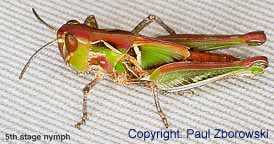Nymph description 1 of 15

Distribution

Nymph Description: Colour more commonly brown but can be green. From above the thorax has a similar 'X' mark to the adult. In early instars the hind part of the 'X' is more pronounced. The rear leg femur has distinct bands, seen as 3 light and 3 dark from above in early instars, or 3 light and 2 dark in later ones. From the side the bands are at 90 degrees across the femur. The rear tibia is dark except for a light band at the top. From the side the rest of the body has general mottling rather than distinct patterns.
Confusion with other nymphs: Austroicetes share some of the same features. A. cruciata can also form bands during outbreaks but it is found only in the southern and more arid parts of the plague locust distribution. Compare photo with nymphs of similar species: | Austroicetes | Aiolopus | Caledia | Heteropternis | Oedaleus | Peakesia | Urnisa |
Unique features: The combination of the 'X' mark on top of the thorax with general mottling, transverse bands on the femur and a dark tibia with a light band at the top distinguish them from most other nymphs. Forms into dense aggregations, called bands, when numbers are high.
Further information on this species: Description of adult, More images, Distribution, Biology
